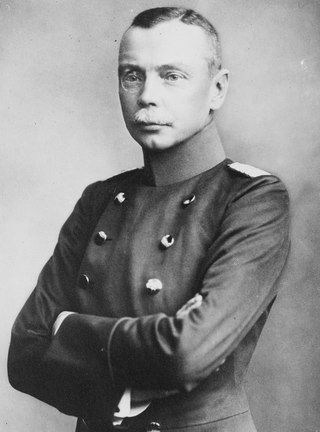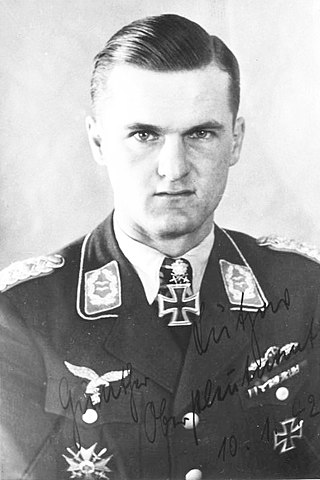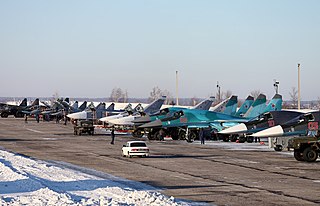
The Luftwaffe was the aerial-warfare branch of the Wehrmacht before and during World War II. Germany's military air arms during World War I, the Luftstreitkräfte of the Imperial Army and the Marine-Fliegerabteilung of the Imperial Navy, had been disbanded in May 1920 in accordance with the terms of the 1919 Treaty of Versailles which banned Germany from having any air force.

Reichswehr was the official name of the German armed forces during the Weimar Republic and the first years of the Third Reich. After Germany was defeated in World War I, the Imperial German Army was dissolved in order to be reshaped into a peacetime army. From it a provisional Reichswehr was formed in March 1919. Under the terms of the Treaty of Versailles, the rebuilt German Army was subject to severe limitations in size, structure and armament. The official formation of the Reichswehr took place on 1 January 1921 after the limitations had been met. The German armed forces kept the name Reichswehr until Adolf Hitler's 1935 proclamation of the "restoration of military sovereignty", at which point it became part of the new Wehrmacht.

The Arado Ar 68 was a single-seat biplane fighter designed and produced by the German aircraft manufacturer Arado Flugzeugwerke. It was among the first fighters produced when Germany abandoned the restrictions of the Treaty of Versailles and began rearming.

Johannes "Hans" Friedrich Leopold von Seeckt was a German military officer who served as Chief of Staff to August von Mackensen and was a central figure in planning the victories Mackensen achieved for Germany in the east during the First World War.

The Arado Ar 64 was a single-seat biplane fighter designed and produced by the German aircraft manufacturer Arado. It was among the first fighters produced when Germany abandoned the restrictions of the Treaty of Versailles and began rearming.

The Albatros L 65 was a German two-seat reconnaissance fighter biplane first flown in 1925.

Lipetsk Air Base is an air base in Lipetsk Oblast, Russia located 12 km northwest of Lipetsk. It is the chief combat training center of the Russian Aerospace Forces, analogous to the United States Air Force's Nellis Air Force Base. The base is made up of two medium-sized airfields joined together.

Günther Lützow was a German Luftwaffe aviator and fighter ace credited with 110 enemy aircraft shot down in over 300 combat missions. Apart from five victories during the Spanish Civil War, most of his claimed victories were over the Eastern Front in World War II. He also claimed 20 victories over the Western Front, including two victories—one of which was a four-engined bomber—flying the Messerschmitt Me 262 jet fighter.

The Fokker D.XIII was a fighter aircraft produced in the Netherlands in the mid-1920s. It was a development of the Fokker D.XI with a new powerplant and considerably refined aerodynamics, and had been designed to meet the requirements of the clandestine flying school operated by the German Army at Lipetsk in the Soviet Union. Like its predecessor, it was a conventional single-bay sesquiplane with staggered wings braced by V-struts. The pilot sat in an open cockpit and the undercarriage was of fixed, tailskid type. The wings were made of wood and skinned with plywood, and the fuselage was built up of welded steel tube with fabric covering.

The Heinkel HD 37 was a fighter aircraft, designed in Germany in the late 1920s, but produced in the USSR for Soviet Air Force service. It was a compact, single-bay biplane with staggered wings of unequal span, braced by N-type interplane struts. The pilot sat in an open cockpit, and the main units of the tailskid undercarriage were linked by a cross-axle.

The Heinkel HD 38 was a fighter aircraft developed in Germany in the late 1920s. It was a compact, single-bay biplane with staggered wings of unequal span, braced with N-type interplane struts, a refined version of the HD 37 that had been evaluated and rejected by the Reichswehr for use at the secret training facility at Lipetsk. The HD 38 was designed in the hope of capturing a different niche - that of a seaplane fighter, and was designed with a twin pontoon undercarriage that could be quickly removed and replaced with wheels. It was accepted in this role, but did not serve in it for long before being relegated to general training duties. Even then, it was not long before Germany abandoned the Lipetsk base to the Soviet Union.
The Junkers J 21 was a reconnaissance aircraft designed in Germany in the early 1920s and produced in the Soviet Union at the Junkers plant at Fili for use by the Soviet Air Force.

The Junkers K 47 was a two-seater fighter aircraft developed in Sweden by the Swedish subsidiary of the German firm Junkers during the late 1920s, a civil development of which was designated the A 48.

Emil Thuy, Pour le Merite, Württemberg's Order of Military Merit, House Order of Hohenzollern, Iron Cross First and Second Class, was one of the leading German fighter aces of World War I, with 35 victories. After the war, he was an adviser to the Finnish air force and was involved in the secret origins of the Luftwaffe within the Soviet Union.

German rearmament was a policy and practice of rearmament carried out by Germany from 1918 to 1939, in violation of the Treaty of Versailles which required German disarmament after WWI to prevent it from starting another war. It began on a small, secret, and informal basis shortly after the treaty was signed, but was openly and massively expanded after the Nazi Party came to power in 1933.

General Hermann von der Lieth-Thomsen was a German military aviation pioneer, a senior air commander in the Imperial German Army Air Service during World War I, and a founding father of the German military aviation.

The Wehrmacht were the unified armed forces of Nazi Germany from 1935 to 1945. It consisted of the Heer (army), the Kriegsmarine (navy) and the Luftwaffe. The designation "Wehrmacht" replaced the previously used term Reichswehr and was the manifestation of the Nazi regime's efforts to rearm Germany to a greater extent than the Treaty of Versailles permitted.
The Kama tank school was a secret training school for tank commanders operated by the German Reichswehr near Kazan, Soviet Union. It operated from 1929 to 1933. The school was established in order to allow the German military to circumvent the military restrictions on tank research spelled out in the Treaty of Versailles. Apart from Kama, for the same reason Germany also operated the Lipetsk fighter-pilot school (1926–33) and a gas warfare facility, Gas-Testgelände Tomka (1928–31).

The 4th Centre for Combat Employment and Retraining of Personnel VVS of the Russian Aerospace Forces is a research, training, and instructional centre. It was formed at Tambov on 19 April 1953. In 1954 it was transferred to Voronezh Malshevo and 1960 to the Lipetsk air base, and then was transformed into the 4th Centre deployment and retraining flight personnel of the Air Force. It was part of the Air Forces of the Moscow Military District for decades.

Tomka gas test site was a secret chemical weapons testing facility near a place codenamed Volsk-18, 20 km off Volsk, now Shikhany, Saratov Oblast, Russia created within the framework of German-Soviet military cooperation to circumvent the demilitarization provisions of the post-World War I Treaty of Versailles. It was co-directed by Yakov Moiseevich Fishman, and German chemists Alexander von Grundherr and Ludwig von Sicherer. It operated during 1926-1933.


















